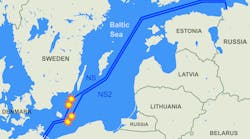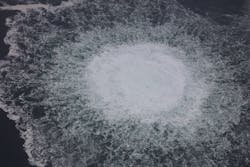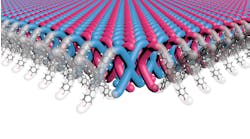The September 26 blasts that ruptured the Nord Stream gas pipelines in the Baltic Sea have prompted fears about release of contaminants from long-discarded chemical weapons and other munitions from disrupted sediments and under the seabed.
The €7.5-billion ($7.3-billion), 1,200-km-long pipelines were built to transport natural gas from Russia to Germany and are designed to last at least 50 years. They are operated by Nord Stream, Zug, Switzerland, a consortium of five shareholders. Gazprom International Projects, St. Petersburg, Russia, has a 51% stake.
At full capacity, the pipelines could transport more than 55 billion m3/yr of gas. According to Nord Steam, that’s enough to satisfy the energy demand of more than 26 million European households.
However, the pipelines pass over an area known as the Bornholm basin, where, in 1947, the allies dumped approximately 32,000 tons of Germany’s estimated 65,000-ton chemical weapon stockpile. The primary dumpsite originally was to span no more than a radius of three nautical miles, but later widened to secondary and tertiary zones, spreading the chemicals over a significant area.
In addition, Soviet troops tasked with dumping chemical weapons from Nazi stockpiles in Poland and Germany dropped tons of wooden crates containing them overboard before reaching the agreed dumping ground — further widening the contamination zone.
As part of a 2019 environmental impact assessment for Nord Stream 2 construction work, scientists from the Danish Centre for Environment and Energy (DCE) at Aarhus University, Aarhus, Denmark, carried out investigations of the seabed on, around and under the proposed pipeline route.
Their report, “Nord Stream 2 chemical warfare agents (CWA) marine risk screening,” used chemical analysis of sediment samples to look for CWA residues. Subsequent risk modeling of the tiny level of residues found led the DCE to conclude the selected route added negligible environmental risk.
However, a report in the October 21 issue of Nature quotes Aarhus University environmental scientist Hans Sanderson’s concerns that the violent expulsion of methane from the ruptured pipeline might have sent contaminants into the water column, where they could harm marine wildlife. These contaminants include the radioactive isotope caesium-137, toxic flame-retardant polybrominated diphenyl ethers, and heavy metals including mercury, cadmium and lead.
“The Baltic Sea is basically one of the most heavily polluted seas on the planet. So this sediment here is full of junk. These explosions [also] took place as close to the dump site of these chemical weapons as possible,” he said.
Sanderson is one of two co-authors of the original 2019 environmental impact assessment.
Meanwhile on October 14, the Swedish Coast Guard reported the gas leak — originally 950-m wide — was no longer visible following an overflight of the Swedish economic zone in the Baltic sea and considered the area no longer closed (Figure 1).Following this announcement, Nord Stream sent in a specially equipped survey vessel to gather data at the pipeline damage on Line 1 in the Swedish economic zone.
On November 2, Nord Stream issued a statement on this work: “According to preliminary results of the damage site inspection, technogenic craters with a depth of 3–5 m were found on the seabed at a distance of about 248 m from each other. The section of the pipe between the craters is destroyed, the radius of pipe fragments dispersion is at least 250 m. Experts continue to analyze the survey data.”
While that survey progresses, the pipe repair and subsea intervention (PRSI) emergency pool managed by Equinor, Stavanger, Norway, is preparing to offer its expertise in any future repair activities.
The PRSI, formed in 1987, has over 20 members together responsible for more than 20,000 km of energy pipelines. Their activities range from supply of basic equipment to specialists in hyperbaric welding such as the Trondheim-based Norwegian Science Institute (Sintef).
“It is by no means impossible to repair major pipeline damage. Damage is rare, but it has happened, as a result of material fatigue, impact, wear, adverse chemical processes, pipeline twisting and other unexpected physical incidents,” explains Sintef welding expert and senior research consultant Ragnhild Aune.
“Fortunately, the Nord Stream pipelines are in shallow waters and the damage is located at depths of no more than 100 m. This means that it is possible to carry out repairs using a diver-assisted system, for which emergency procedures for hyperbaric welding — welding under water at great depth — already exist,” she adds.




